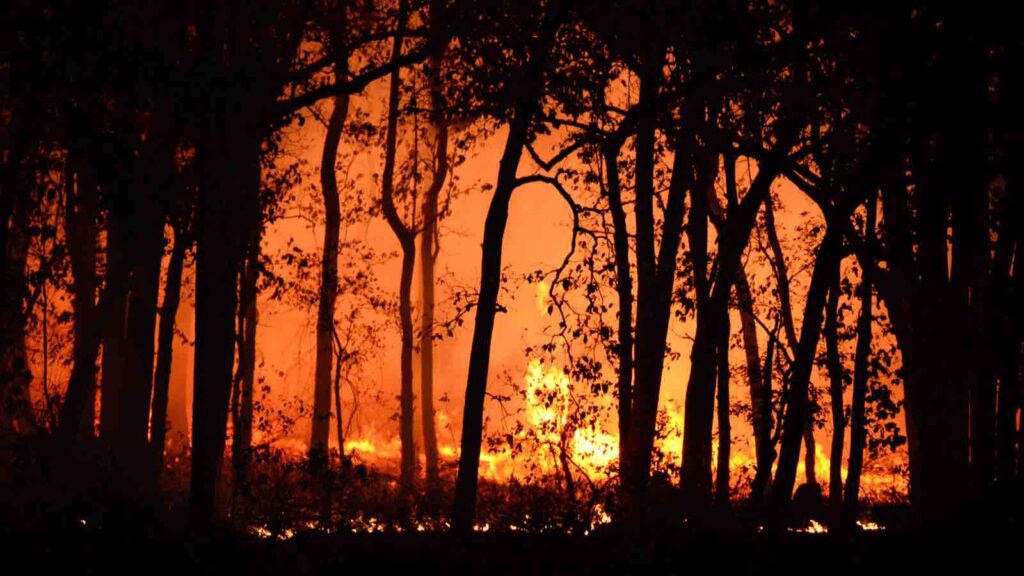Data from Indonesia’s Ministry of Environment and Forestry reveals a staggering 994,313.18 hectares—an expanse 15 times the size of Jakarta—were consumed by fire from January to October 2023.
In 2023, Indonesia witnessed a dramatic escalation in wildfires, with nearly 1 million hectares (approximately 2.47 million acres or fifteen times the size of Jakarta) engulfed in flames from January to October, marking a significant increase in fire incidents attributed to El Niño and land clearing for new plantations. This year’s fires not only signify the worst season since the devastating El Niño-driven blazes of 2019 but also highlight a broader environmental challenge facing the region.
RELEVANT SUSTAINABLE GOALS



Tracking The Blaze
While the 2023 fires mark a fivefold increase from the previous year, covering 204,894 hectares (506,300 acres), they still show a 30.80% decrease from the peak of 2019 when 1.65 million hectares (4.07 million acres) were burned. Despite the lower figures compared to 2019, the Ministry of Environment and Forestry in Jakarta views this as a significant achievement, given the drier conditions experienced in 2023.
At an event on December 27, 2023, Environment and Forestry Minister Siti Nurbaya Bakar predicts the total area affected by fires will increase by the end of 2023. The current figure of 994,313.18 hectares only accounts for fires recorded up to October 2023.
I estimated that by the end of November 2023, the size of fires would grow by more than 200,000 hectares [494,200 acres]; But the 200,000 hectares of burning were mostly on savanna.
Environment and Forestry Minister Siti Nurbaya Bakar
However, the fires are not just a matter of environmental concern; they reflect deeper socio-economic issues. In regions like Central Kalimantan, the lack of formal employment drives locals to convert abandoned farmlands into new plantations through burning, a practice exacerbated by insufficient job creation and the government’s sweeping ban on agricultural fires post-2015. This scenario underscores the urgent need for sustainable job alternatives to discourage land burning for plantation expansion.
Law Enforcement
The Indonesian government has been proactive in preparing for the fire season through measures like increased patrols and cloud seeding. Yet, despite these efforts, significant fires in provinces like South Kalimantan, Central Kalimantan, and South Sumatra indicate the persistent challenge of managing land and forest fires, which remain the largest contributors to Indonesia’s greenhouse gas emissions.
On the legal front, the Ministry of Environment and Forestry has intensified its crackdown on companies and individuals responsible for burning, sealing off affected areas and issuing warnings. While legal actions against companies have led to substantial fines, collecting these penalties remains a challenge, highlighting the complexities of enforcing environmental regulations.
El Niño’s Rising Tide: Predictions for a Warmer 2024
El Niño is poised to intensify in 2024, originating from the warming of sea surface temperatures in the eastern Pacific Ocean near Peru. This heat expands and spreads westward, reaching the waters south of Hawaii and onward to the western Pacific islands near Papua. As of October 29, the Australian Bureau of Meteorology recorded an average monthly warming around the El Niño monitoring point in the waters south of Hawaii (known as the Nino 3.4 area) at 1.66°C above average.
This warming trend is expected to strengthen into the next year. The severe El Niño warming of 2023, initially spotted near Peru (Nino 2 area), was measured at 2.42°C above normal. It is anticipated to take at least two months for this heat to spread to the Nino 3.4 monitoring point. Therefore, by October 21, 2023, the Australian Bureau of Meteorology estimated that the peak of El Niño would occur in January 2024, with monthly average surface temperatures potentially reaching 2.7°C above normal in the Nino 3.4 area.
Erma Yulihastin, a researcher from Indonesia’s National Research and Innovation Agency (BRIN), considers the modeling by the Australian Bureau of Meteorology to be highly reliable, based on long-term climatological data from 1960 to 2010. Despite being 13 years old, this historical data is crucial for comparing the current behavior of El Niño with past events in 1997-1998 and 2015-2016.
The Australian forecast aligns with predictions from Japan’s Agency for Marine-Earth Science and Technology (Jamstec), which also suggests that El Niño’s peak warming will exceed 2°C.
As Indonesia, and Southeast Asia at large, grapple with the dual challenges of climate change and economic development, the fires of 2023 serve as a stark reminder of the intricate balance required to protect the environment while ensuring economic viability for its people. The road ahead demands innovative solutions, stronger enforcement of environmental laws, and a collective commitment to sustainable development.
Lead image courtesy of Deep Rajwar via Pexels
You may also be interested in :
Forest Restoration : How Human Intervention Accelerates Ecosystem Recovery In Borneo Rainforest


